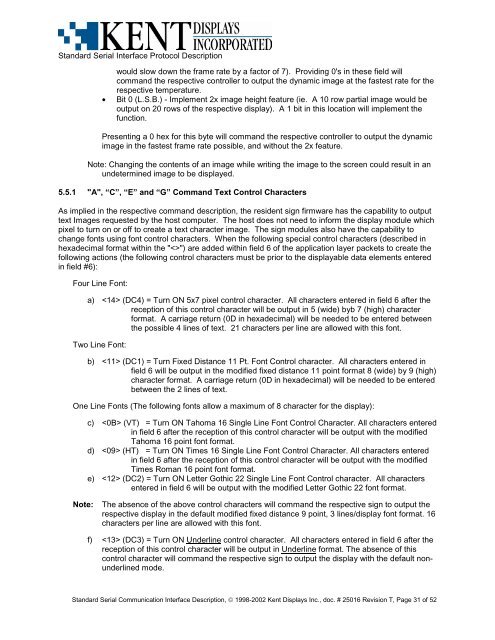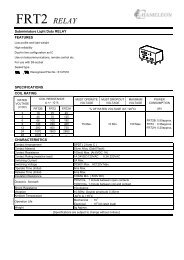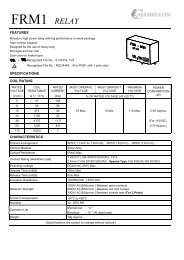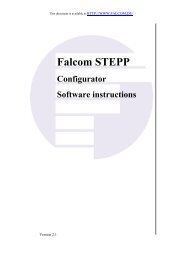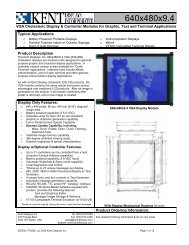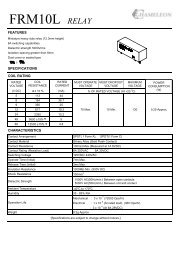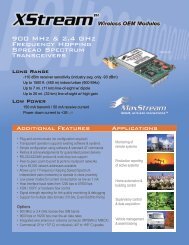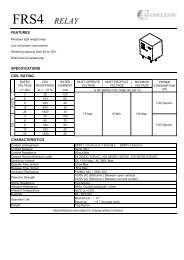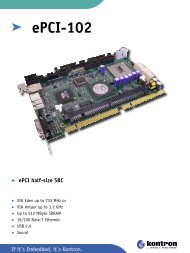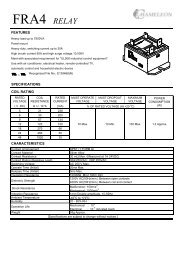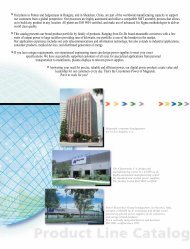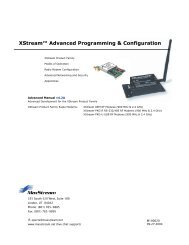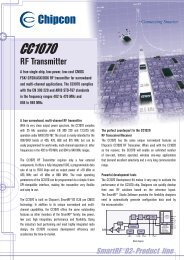STANDARD SERIAL COMMUNICATION INTERFACE and ...
STANDARD SERIAL COMMUNICATION INTERFACE and ...
STANDARD SERIAL COMMUNICATION INTERFACE and ...
You also want an ePaper? Increase the reach of your titles
YUMPU automatically turns print PDFs into web optimized ePapers that Google loves.
St<strong>and</strong>ard Serial Interface Protocol Description<br />
would slow down the frame rate by a factor of 7). Providing 0's in these field will<br />
comm<strong>and</strong> the respective controller to output the dynamic image at the fastest rate for the<br />
respective temperature.<br />
• Bit 0 (L.S.B.) - Implement 2x image height feature (ie. A 10 row partial image would be<br />
output on 20 rows of the respective display). A 1 bit in this location will implement the<br />
function.<br />
Presenting a 0 hex for this byte will comm<strong>and</strong> the respective controller to output the dynamic<br />
image in the fastest frame rate possible, <strong>and</strong> without the 2x feature.<br />
Note: Changing the contents of an image while writing the image to the screen could result in an<br />
undetermined image to be displayed.<br />
5.5.1 "A", “C”, “E” <strong>and</strong> “G” Comm<strong>and</strong> Text Control Characters<br />
As implied in the respective comm<strong>and</strong> description, the resident sign firmware has the capability to output<br />
text Images requested by the host computer. The host does not need to inform the display module which<br />
pixel to turn on or off to create a text character image. The sign modules also have the capability to<br />
change fonts using font control characters. When the following special control characters (described in<br />
hexadecimal format within the "") are added within field 6 of the application layer packets to create the<br />
following actions (the following control characters must be prior to the displayable data elements entered<br />
in field #6):<br />
Four Line Font:<br />
a) (DC4) = Turn ON 5x7 pixel control character. All characters entered in field 6 after the<br />
reception of this control character will be output in 5 (wide) byb 7 (high) character<br />
format. A carriage return (0D in hexadecimal) will be needed to be entered between<br />
the possible 4 lines of text. 21 characters per line are allowed with this font.<br />
Two Line Font:<br />
b) (DC1) = Turn Fixed Distance 11 Pt. Font Control character. All characters entered in<br />
field 6 will be output in the modified fixed distance 11 point format 8 (wide) by 9 (high)<br />
character format. A carriage return (0D in hexadecimal) will be needed to be entered<br />
between the 2 lines of text.<br />
One Line Fonts (The following fonts allow a maximum of 8 character for the display):<br />
c) (VT) = Turn ON Tahoma 16 Single Line Font Control Character. All characters entered<br />
in field 6 after the reception of this control character will be output with the modified<br />
Tahoma 16 point font format.<br />
d) (HT) = Turn ON Times 16 Single Line Font Control Character. All characters entered<br />
in field 6 after the reception of this control character will be output with the modified<br />
Times Roman 16 point font format.<br />
e) (DC2) = Turn ON Letter Gothic 22 Single Line Font Control character. All characters<br />
entered in field 6 will be output with the modified Letter Gothic 22 font format.<br />
Note:<br />
The absence of the above control characters will comm<strong>and</strong> the respective sign to output the<br />
respective display in the default modified fixed distance 9 point, 3 lines/display font format. 16<br />
characters per line are allowed with this font.<br />
f) (DC3) = Turn ON Underline control character. All characters entered in field 6 after the<br />
reception of this control character will be output in Underline format. The absence of this<br />
control character will comm<strong>and</strong> the respective sign to output the display with the default nonunderlined<br />
mode.<br />
St<strong>and</strong>ard Serial Communication Interface Description, © 1998-2002 Kent Displays Inc., doc. # 25016 Revision T, Page 31 of 52


